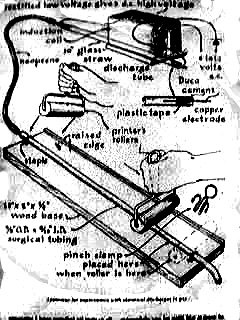|
This is a modern version of the linear peristaltic air pump.
Its design was inspired by both Nyle's prior art and my current
knowledge of modern rotary oil-sealed
air pumps used for vacuum service.
Notice that the discharge tube is still running as seen in
this picture.
This pump incorporates an exhaust check valve made from rubber
bands over the exit end that prevents
the air from returning back to the evacuated pump and chamber when
one stops rolling the hose.
Gone is the additional brayer guide. The hose is secured to
the stick by the gaffer's tape.
Now the hose will not squirm out from under the brayers.
Additionally the stick with attached hose is secured to the
table so the whole assembly will not wander
when rolled.
Additionally the long tube and the other dead volumes that
connected the pump hose to the discharge
chamber have been eliminated; minimizing the number
of joins, using the maximum diameter of tube
and the shortest connections possible maximizes the
effectiveness of this demonstration.
This is in accordance with good vacuum practice.
Because the discharge tube is small, in comparison to the swept
pump volume, operating pressure is
quickly reached with only a few strokes of the hose
with the brayers.
|

